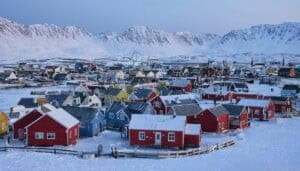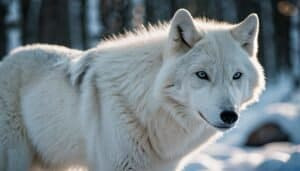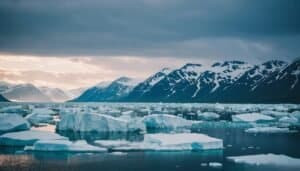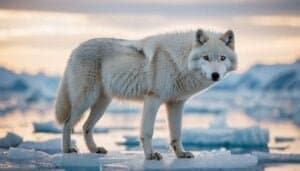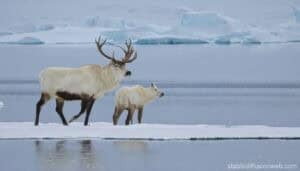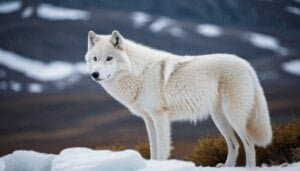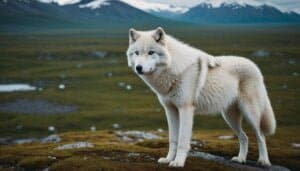Introduction
Arctic wolves have long been admired for their beauty and resilience, but in contemporary Arctic literature, they hold a much deeper significance
These majestic creatures are often used to symbolize the untamed wilderness, the challenges of survival, and humanity’s complex relationship with nature. Throughout modern works, Arctic wolves are depicted not only for their physical traits but also for their integral roles in the Arctic ecosystem
This article explores how Arctic wolves are portrayed symbolically, ecologically, and culturally in literature, diving into their representation as metaphors, their connection to indigenous stories, and their environmental significance
Let’s delve into how Arctic wolves continue to inspire and captivate readers through the pages of Arctic literature
Symbolic Meaning of Arctic Wolves in Literature
Arctic wolves in contemporary literature are often imbued with profound symbolic meanings that resonate deeply with themes of wilderness, resilience, and isolation
These animals, with their stark white fur and sharp gaze, often embody the untamed essence of the Arctic itself—a land of extremes, beauty, and unforgiving challenges
Writers utilize Arctic wolves as a metaphorical bridge, connecting readers to the raw and uncharted territories of both nature and the human spirit. Their portrayal often reflects a duality of existence: both predator and protector, survivor and symbol of fragility
Role of Arctic Wolves in Representing the Wild
Arctic wolves are frequently depicted as living embodiments of the wild’s primal forces. In Jack London-inspired narratives, the Arctic wolf often symbolizes the sheer indifference of nature—its brutal yet awe-inspiring essence
For instance, contemporary author Sophie Lingard, in her work on Arctic ecosystems, describes wolves as “the vigilant stewards of a land untouched by man, epitomizing the wilderness’ enduring power”
This portrayal underscores their role as guardians of an ecosystem that resists human intrusion. The wolves’ howls echo not just across the tundra but across the pages of literature as a haunting reminder of nature’s sovereignty
Symbolism of Survival and Adaptation
Few creatures embody survival and adaptation as profoundly as the Arctic wolf. Contemporary narratives often highlight their ability to thrive in harsh, unforgiving environments as a parallel to human resilience
This theme is especially evident in survivalist literature, where Arctic wolves mirror protagonists’ struggles to endure isolation and scarcity. In novels like “Winter’s Calling” by Dr. Henry Calloway, the wolves’ ability to hunt and navigate vast frozen expanses serves as a beacon of inspiration for characters battling the elements
Moreover, these wolves are frequently positioned as symbols of change and adaptation in the face of adversity. As climate change reshapes the Arctic landscape, the wolves’ resilience becomes a poignant reminder of the broader need for adaptability and coexistence
Arctic Wolves as Metaphors for Isolation
Arctic wolves often serve as metaphors for solitude and the psychological struggles of isolation. In many narratives, the lone wolf wandering the tundra is a powerful image of introspection, detachment, and self-reliance
Authors like Elaine Marcus emphasize this metaphorical role, depicting Arctic wolves as solitary wanderers navigating vast and empty landscapes, much like the human soul grappling with loneliness and existential challenges
These metaphorical layers deepen the reader’s connection to both the wolves and the Arctic environment, fostering a sense of empathy and understanding for the isolation inherent in both. Such narratives often evoke a powerful message: in the wilderness, survival is a shared experience, even among the most solitary of beings
Physical and Ecological Depictions of Arctic Wolves
Arctic wolves are not only significant as symbols in literature but are also admired for their physical attributes and their integral roles within the Arctic ecosystem
Writers often draw attention to the wolves’ unique adaptations to extreme climates, showcasing their physical and ecological traits as a testament to nature’s ingenuity. These depictions emphasize the wolves’ contributions to maintaining ecological balance in the fragile Arctic environment
Accurate Descriptions in Modern Novels
In contemporary literature, Arctic wolves are portrayed with remarkable attention to detail, reflecting their real-life characteristics
Their dense, white fur is described as both a camouflage against the snow and a shield against freezing temperatures, often serving as a literary device to illustrate resilience. Authors like Dr. Sophie Lingard vividly capture their piercing eyes and agile movements, which convey a sense of mystery and predatory precision.
In novels such as “Snow Guardians,” writers delve into their physical features not just for authenticity but to evoke awe and respect for these animals
Their large paws, which act as natural snowshoes, are frequently mentioned as a metaphor for adaptation and survival, symbolizing how life persists even in the most hostile environments
Arctic Wolves in the Ecosystem
Ecological themes are central to many works that feature Arctic wolves, underscoring their critical role in maintaining the Arctic’s delicate balance
Arctic wolves are apex predators, regulating prey populations such as musk oxen and Arctic hares. This role is often highlighted in literature to symbolize the interconnectedness of all life in the region
For example, Dr. Alex Andersson’s analysis of predator-prey dynamics in literature reveals how Arctic wolves are often depicted as arbiters of natural order. When prey populations dwindle due to environmental changes, the wolves’ struggle mirrors larger ecological imbalances, adding depth to narratives about environmental conservation
This portrayal reinforces their importance not just as individual creatures but as key players in a broader ecological narrative
Environmental Changes Affecting Wolf Narratives
As climate change disrupts Arctic habitats, literature increasingly reflects the challenges faced by Arctic wolves
Melting ice and shrinking tundra landscapes are common backdrops in contemporary stories, where wolves are depicted as symbols of resilience against a rapidly changing world. These portrayals often serve as allegories for humanity’s impact on the environment and the urgency of conservation efforts
In “Frozen Echoes,” a novel by Maria Redfeather, the wolves’ struggle to adapt to a warming Arctic is juxtaposed with the lives of indigenous characters who also face cultural and environmental shifts
The parallels drawn between the wolves and the human characters emphasize the interconnected fate of all Arctic inhabitants
Through such depictions, Arctic wolves in literature not only embody the challenges of survival but also serve as reminders of the consequences of environmental neglect and the resilience needed to address it
Cultural and Human Connections in Literature
Arctic wolves hold a profound place in literature as cultural symbols and figures that bridge the gap between humanity and the natural world
Their presence is often intertwined with indigenous traditions and narratives, emphasizing their spiritual and ecological significance. Contemporary authors frequently explore the dynamic relationships between Arctic wolves and humans, reflecting themes of respect, fear, and coexistence
Indigenous Stories Featuring Arctic Wolves
For many indigenous Arctic cultures, the Arctic wolf is more than just an animal; it is a spiritual entity deeply embedded in myths and legends. These narratives often portray the wolf as a guide, protector, or embodiment of resilience and wisdom
Literature inspired by these traditions highlights the wolf’s sacred role, offering readers a glimpse into indigenous perspectives on the interconnectedness of all life
Dr. Maria Redfeather’s research, for instance, delves into how Arctic wolves appear in native storytelling. In many tales, wolves are seen as intermediaries between the physical and spiritual realms, often guiding lost travelers or teaching survival lessons through their behavior
Contemporary authors who draw on these stories, like those featured in the anthology “Echoes of the Arctic Spirit”, use wolves to symbolize a harmonious existence with nature
Human-Wolf Relationships in Contemporary Novels
Modern literature frequently explores the complex and multifaceted relationships between Arctic wolves and humans
These narratives often juxtapose the wolves’ wild instincts with human attempts to understand or control nature. In survivalist tales, wolves are sometimes depicted as rivals or threats, while in other stories, they serve as companions or symbols of hope
In “The Silent Snow,” by Dr. Henry Calloway, the protagonist forms an unlikely bond with an Arctic wolf, illustrating themes of mutual respect and shared survival in a harsh landscape
Such depictions highlight the fragile line between coexistence and conflict, reflecting broader questions about humanity’s role in the natural world
Arctic Wolves and Cultural Resilience
The portrayal of Arctic wolves often parallels the struggles of indigenous communities facing cultural erosion and environmental challenges. As climate change and modernization encroach on traditional ways of life, literature uses the wolf as a metaphor for cultural resilience and adaptation
This theme is particularly evident in works like Maria Redfeather’s “Wolves of the Icefields,” where the wolves’ survival mirrors the endurance of Arctic peoples in preserving their heritage
Authors also explore the idea of wolves as cultural icons, representing both the wildness of the Arctic and the enduring strength of those who inhabit it
These stories serve as a poignant reminder of the interconnected fate of humans, wolves, and the land they share, encouraging readers to reflect on their responsibilities toward preserving these relationships
Conclusion
Arctic wolves in contemporary Arctic literature embody a rich tapestry of symbolism, ecological importance, and cultural connections
Through their representation, these wolves emerge as powerful symbols of wilderness, survival, and adaptation, often reflecting the complexities of human experiences in extreme environments
Writers craft their portrayals with vivid detail, showcasing their physical traits and ecological roles, while addressing pressing issues like climate change and environmental fragility
Furthermore, Arctic wolves serve as bridges between human and natural worlds, often holding spiritual significance in indigenous narratives and acting as metaphors for resilience and coexistence. Their stories are not only a tribute to the Arctic’s stark beauty but also a reminder of the interconnectedness of all life
As literature continues to evolve, Arctic wolves remain a poignant and enduring figure, captivating readers and inspiring reflection on the challenges and wonders of the Arctic world


